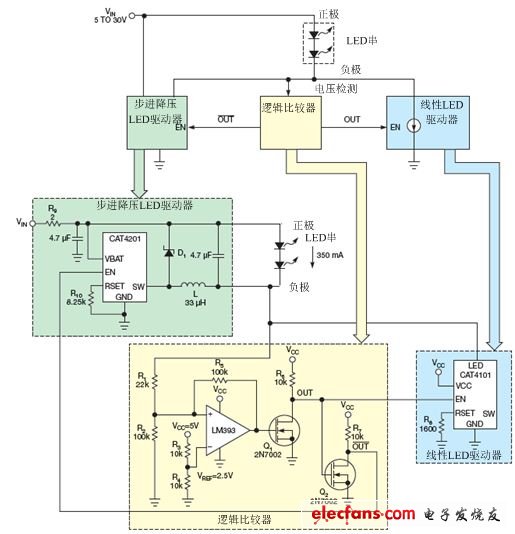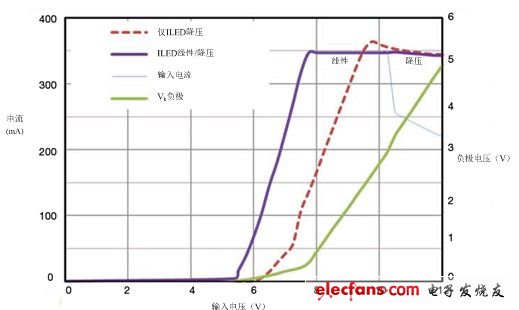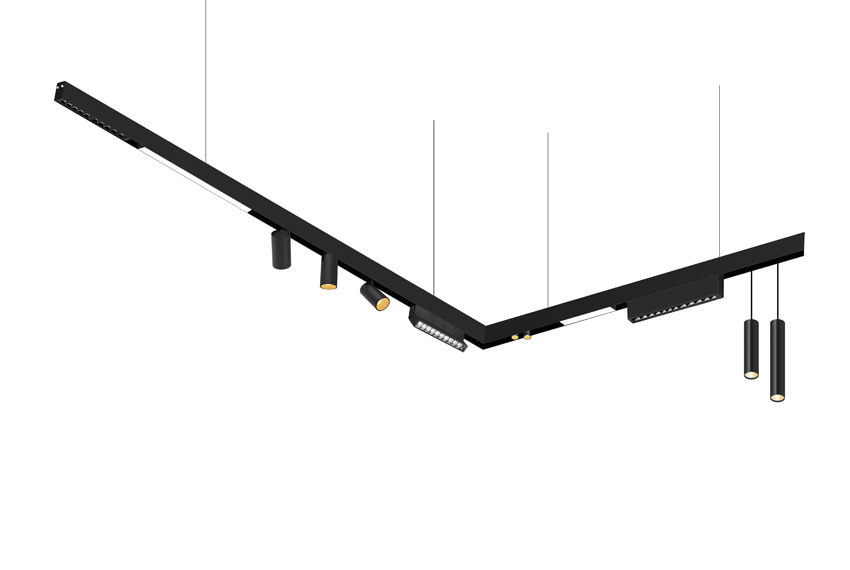To control the brightness, the light emitting diode (LED) requires a constant current. This can be achieved by connecting a resistor in series with a group of LEDs. Since the voltage and supply voltage of a group of LEDs may change, a dedicated LED driver must be used to ensure the accuracy of the current. The following two schemes are widely used: linear constant current LED drivers and step-down buck switching converters, each of which has its own advantages and disadvantages.
Linear drive is a simple solution with very few components and basically no noise. However, the heat dissipated and the supply voltage are proportional to the difference between the LED forward voltage. To prevent overheating, the package may require an additional heat dissipation area on the PCB, which increases the cost and quantity of the required PCB, and also increases the risk of the driver IC shutting down due to thermal shutdown, thereby turning off the LED.

Figure 1 The LM393 comparator monitors the low-side voltage of the LED string and enables a buck regulator (CAT4201) or linear regulator (CAT4101).
If the driver is placed next to the LED, the extra heat will cause the LED to operate at a higher temperature, thereby reducing its life. The buck (or buck) converter has high efficiency and generates very little heat, but the switching scheme requires an inductor and a Schottky diode. This scheme also generates noise, especially when the supply voltage drops to the LED forward voltage. In automotive applications, radio frequency interference (RFI) is an important consideration. It is recommended to place an EMI / RFI filter in front of the opening converter to prevent the noise generated by the high-frequency conversion from returning to the power supply because it may interfere with AM / FM band radios and other equipment.
When the performance of the buck converter is poor and the margin is used up, the operation of the linear driver is optimal. In order to avoid disadvantages and take advantage of the two schemes, a scheme combining linearity and buck can be adopted to ensure the efficiency while minimizing the conversion noise.
Ideally, the battery voltage fluctuates greatly. As in automotive application scenarios (8v to 17v), linear / buck drivers can provide the required lower noise operating environment and higher efficiency. When the applied voltage rises above the limit, the LED driver switches to buck mode to avoid overheating the linear driver.
The circuit in this article can individually select the adjustable voltage threshold of each LED driver when switching between switching mode and linear mode, and has additional hysteresis to ensure a smooth conversion. The schematic shown in Figure 1 uses ON Semiconductor's CAT4201 350-mA buck driver and CAT4101 1A constant current LED driver. The logic comparator is also shown. The more common buck structure has a high-side switch and a low-side diode, CAT4201 is different, it interchanges these devices.
Like a typical buck switch, when the switch is turned on, the current flowing through the inductor L and the LED will increase until it reaches a peak value, that is, twice the average LED current. Then the switch is turned off. The charged inductor will force current to continue to flow through Schottky diode D1 and LED until its value becomes zero. Then the cycle began to repeat. This switching operation is called critical conduction mode.
The R1 / R2 resistor divider produces V + equivalent to a fraction of the negative voltage. If the input voltage of the comparator (LM393) is higher than the fixed reference voltage value of 2.5V, the output is high; OUT is low and linearity is disabled Driver to enable the buck converter. If V + is lower than the reference voltage, the comparator output is low, enabling the linear driver and disabling the buck converter. The feedback resistor R5 adds a hysteresis of 0.6V, that is, once the negative voltage exceeds 3.6V, the buck converter will start; when the negative voltage drops below 3V, the linear driver will take over. Note that if the other half of the LM393 is not used for other LED power supplies, a better design method is to ground all unused input and output leads on the LM393.
Figure 2 shows the LED current regulation when a single buck converter and linear / buck driver are used together. Compared with a single-use buck converter, the linear / buck driver can extend the LED current regulation to a supply voltage of less than 8V. Even if the battery voltage continues to drop, it can keep the LED lit. When the power supply voltage is lower than 11V, the buck converter alone will lose its accuracy and generate more switching ripple current back to the power supply. EMI filters are more difficult to suppress ripple current at lower frequencies. On the other hand, within the same supply voltage range, linear drives provide higher regulation and noise-free operating environment.
Despite the increased component count, for applications requiring low noise performance and extended power supply ranges, the combined linear / buck solution is valuable. The transition voltage from linear to buck can be set to obtain the best heat dissipation performance.

Figure 2 Compared with the buck converter only, the linear / buck current sink can extend the current regulation range to a lower supply voltage (below 8V) and reduce EMI at low power. Therefore, the LED is in the battery It can remain lit even when the voltage is low.
Magnetic Led Light system is new trend and hotsale product, this product have various dimmable function, and It's include smart magnetic light, magnetic LED Track Light , Linear Magnetic Led Light, magnetic folding light, magnetic spot light, magnetic pendant light, magnetic grille light. Except the magnetic led light, we can provide general 2wire 3wire 4wire Track Light , Led Down Light , led pendant light, LED Linear Light.

Linear Magnetic Led Light,Embedded Track Rail,Smart Magnetic Light,Magnetic Led Linear Light
Guangdong Decosun Lighting Technology Co.,Ltd , https://www.decosun-lighting.com